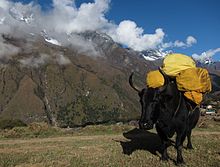Dzo
| Dzo | |
|---|---|

| |
| A dzo acting as a pack animal en route to Mount Everest | |
Domesticated
| |
| Scientific classification | |
| Kingdom: | Animalia |
| Phylum: | Chordata |
| Class: | Mammalia |
| Order: | Artiodactyla |
| Family: | Bovidae |
| Subfamily: | Bovinae |
| Tribe: | Bovini |
| Genus: | Bos |
| Species: | |
A dzo (Tibetan མཛོ་ mdzo) (also spelled zo, zho and dzho) is a hybrid between the yak and domestic cattle. The word dzo technically refers to a male hybrid, while a female is known as a dzomo or zhom. In Mongolian, it is called a khainag (хайнаг). There is also the English language portmanteau term of yattle, a combination of the words yak and cattle,[1] as well as yakow,[2][3] a combination of the words yak and cow.
Dzomo are fertile (or, fecund) while dzo are sterile. As they are a product of the hybrid genetic phenomenon of heterosis (hybrid vigor), they are larger and stronger than yak or cattle from the region.[4] In Mongolia and Tibet, khainags are thought to be more productive than cattle or yaks in terms of both milk and meat production.[5][6]
Dzomo can be back crossed. As a result, many supposedly pure yak or pure cattle probably carry each other's genetic material. In Mongolia, the result of a khainag crossed with either a domestic bull or yak bull is called ortoom (ортоом, three-quarter-bred) and an ortoom crossed with a domestic bull or yak bull results in a usan güzee (усан гүзээ, one-eighth-bred).[6][7]
Dzo inherit two different types of proteins, one from each parent, and their mitochondrial structure and function changes.[8] This significantly changes the dzo's ability to survive in higher altitudes than both parents can. Hybrid species are more often than not weaker or not able to survive. However, this particular species is more successful in ways, such as strength and size, that cattle and Yaks cannot achieve.
See also[]
- Bovid hybrid
- Yakalo, a yak/buffalo (American bison) hybrid
References[]
- ^ Mummolo, Jonathan (August 11, 2007). "Yattle What?". The Washington Post. Retrieved January 3, 2017.
Mentzer, who grew up farming in Loudoun County, and his partner, Jim Dumbrell, a retired British oil and gas pipeline consultant, are breeding yattle -- a cross between cows and yaks.
- ^ National Research Council (1983). Little-Known Asian Animals With a Promising Economic Future. Washington, D.C.: The National Academies Press. p. 34. doi:10.17226/19514. ISBN 978-0-309-32715-2.
- ^ Mason, Ian (March 2002). Porter, Valerie (ed.). Mason's World Dictionary of Livestock Breeds, Types and Varieties. West Sussex: CABI. p. 122. ISBN 085199430X.
- ^ David B. Madsen; Fa-Hu Chen; Xing Gao (3 July 2007). Late Quaternary Climate Change and Human Adaptation in Arid China. Elsevier. p. 207. ISBN 978-0-444-52962-6.
- ^ Bataagiin Bynie: Mongolia: The Country Refort (sic!) On Animal Genetic Resources, Ulaanbaatar 2002, p. 11
- ^ a b Tsering, Diki (2002). Dalai Lama, My Son. Penguin Books. ISBN 0-7865-2260-7.
- ^ Takase Hisabumi, Kh. Tumennasan et al., "Fertility Investigation in F1 Hybrid and Backcross Progeny of Cattle (Bos taurus) and Yak (Bos gruniens) in Mongolia: II. Little variation in gene products studied in male sterile and fertile animals", in: Niigata journal of health and welfare Vol. 2, No. 1, pp. 42–52.
- ^ Long, L., Zhu, Y., Li, Z., Zhang, H., Liu, L., & Bai, J. (2020). Differential expression of skeletal muscle mitochondrial proteins in yak, dzo, and cattle: a proteomics-based study. The Journal of veterinary medical science, 82(8), 1178–1186. https://doi.org/10.1292/jvms.19-0218
External links[]
- Domesticated animals
- Bovid hybrids
- Cattle stubs